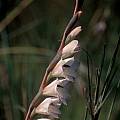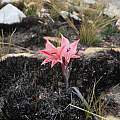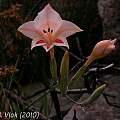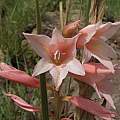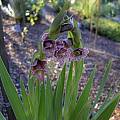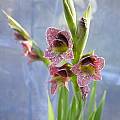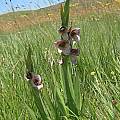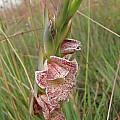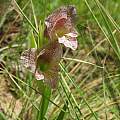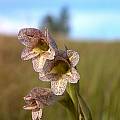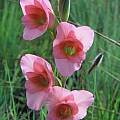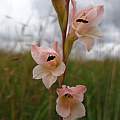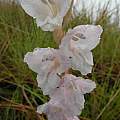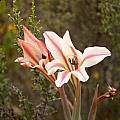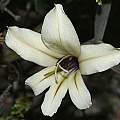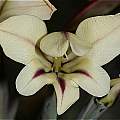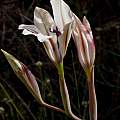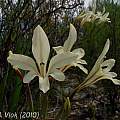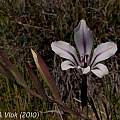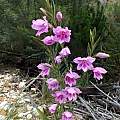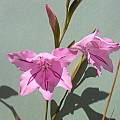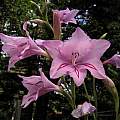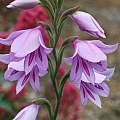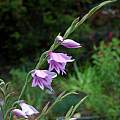From pale rose and mauve to salmon to screaming pink, this color complex offers many shades and the widest range of species in the color indices.
Page 1: G. anatolicus... Page 2: G. carmineus... Page 4: G. gracilis... Page 5: G. maculatus... Page 6: G. nigromontanus... Page 7: G. phoenix... Page 8: G. saxatilis... Page 9: G. vernus...
Gladiolus densiflorus Baker is a species found in the lowveld and coast of eastern southern Africa. It grows in open grassland, usually on deep soils in high (summer) rainfall areas. It has small, short tubed, cream, greenish, pink, mauve, slate-grey or occasionally orange flowers that are usually minutely speckled with pink to purple spots. Photo taken by Rod Saunders.
Gladiolus dolichosiphon Goldblatt & J.C-Manning was first described in 2009, after a first collection from 1986 wasn't correctly identified as new species. It grows on seasonally wet places on cool south-facing slopes in altitudes above 1300 m in the western little Karoo. The flower spike holding 4 to 7 seven pink to creamy salmon unscented flowers with the lower three tepals each with a pale lozenge-shaped median mark outlined in dark red may have up to two lateral branches. It is a member of the long tubed pink flowered Gladiolus carneus complex but is distinguished from that group by its 5 or 6 linear leaves, creamy pink to salmon flowers with a tube 30-50 mm long and longer than the dorsal tepal, and its late summer flowering (late January to mid February). The first photo from Rachel Saunders was taken the second year after a fire, January 2017. The second photo from the book Plants of the Klein Karoo courtesy of Jan and Anne Lise Schutte-Vlok.
Gladiolus dolomiticus Obermeyer is a rare summer rainfall endemic found on dolomite hills, dry woodland, and dolomite slopes at 1700 m in Makapan's Valley in the Northern province. It flowers in March and April at the end of the rainy season. Growing 70 to 100 cm with rigid hairy leaves with thickened margins and primary and secondary veins, it has a spike of 10 to 17 short tubed pale pink flowers. The lower tepals have a blotch in the midline and the throat is pale yellow. Photo from Rachel Saunders.
Gladiolus ecklonii Lehmann (syn. G. marmoratus, G. inclusus) is widespread in the summer rainfall area where it is found in well watered low grassland. It has flowers that are minutely spotted or dotted pink, red or purple on a white background. The lower tepals are yellow to cream. The flowers may be so evenly covered with uniformly pink or dark red spots that they look that color. From a distance the flowers on my plants looks almost brown. The attractive leaves are bright green in a fan with thickened margins. The species is named after C. F. Ecklon, the plant collector who first sent seeds of it to the Hamburg Botanic Garden. The first two photos are of plants blooming September 2004 in California by Mary Sue Ittner.
The first four photos were taken by Cameron McMaster in the Eastern Cape and the last was taken by Rod Saunders.
Gladiolus exiguus G.J.Lewis grows in open grassland in well drained sites at high elevations in the northern Drakensberg escarpment of Mpumalanga, South Africa. Growing from 30 to 40 cm high, it has 7 to 8 leaves with the lower forming a crowded fan and pale creamy to deep pink unscented short tubed flowers. Photo from Rachel Saunders.
Gladiolus ferrugineus Goldblatt & J.C.Manning grows in marshy grassland or well watered stony slopes in the summer rainfall area in eastern Southern Africa from the Northern Province to North Swaziland. Growing from 35-60 cm, it has 6-8 channeled leaves with the largest leaves twisted, and small white to pink short tubed flowers with rust colored bracts. The lower lateral tepals have cream to pale yellow blotches in the midline. There are two distinct forms. The form from the lower escarpment flowers in summer from late November to early February and has broader leaves and shorter tubes and the form from the upper escarpment flowers in autumn (March and April) and has narrower leaves with thickened margins and twisted blades and longer tubes. Photo from Rachel Saunders.
Gladiolus floribundus Jacq. grows on dry clay, sandy or limestone flats and slopes over a broad area of the winter rainfall Cape. It has white to cream or pinkish flowers with a dark median streak on all of the tepals and blooms in late spring. The first two photos taken by Cameron McMaster near Napier in the Overberg. Photos three, four, and five were taken by Andrew Harvie. Photo three was also taken in the Overberg in the De Hoop Nature Reserve. The last two were taken on a a rocky ridge top in the Swartberg Mountains.
Photos below from the book Plants of the Klein Karoo courtesy of Jan and Anne Lise Schutte-Vlok who write that this species grows up to 60 cm tall with broad grey green leaves. It can be confused with Gladiolus grandiflorus which has a shorter tube.
Gladiolus geardii L.Bolus (syn. Gladiolus robustus Goldblatt) is a late spring to summer bloomer (November to January) found on moist sandstone slopes in the southeastern Cape where it gets limited rainfall year round with a bit less in summer. Growing from 80 to 150 cm high, it is described as having sword shaped leaves and pink flowers with darker markings on the lower tepals in a 6 to 10 flowered spike. The dorsal tepal is inclined. In cultivation in a Mediterranean climate, it is not dormant long. The first photo was taken by Rachel Saunders near Port Elizabeth where some very tall plants were in flower December 2013. One had 7 branches and 14 open flowers. The next two photos were taken by Bob Rutemoeller and the last three by Mary Sue Ittner.
Page 1: G. anatolicus... Page 2: G. carmineus... Page 4: G. gracilis... Page 5: G. maculatus... Page 6: G. nigromontanus... Page 7: G. phoenix... Page 8: G. saxatilis... Page 9: G. vernus...
